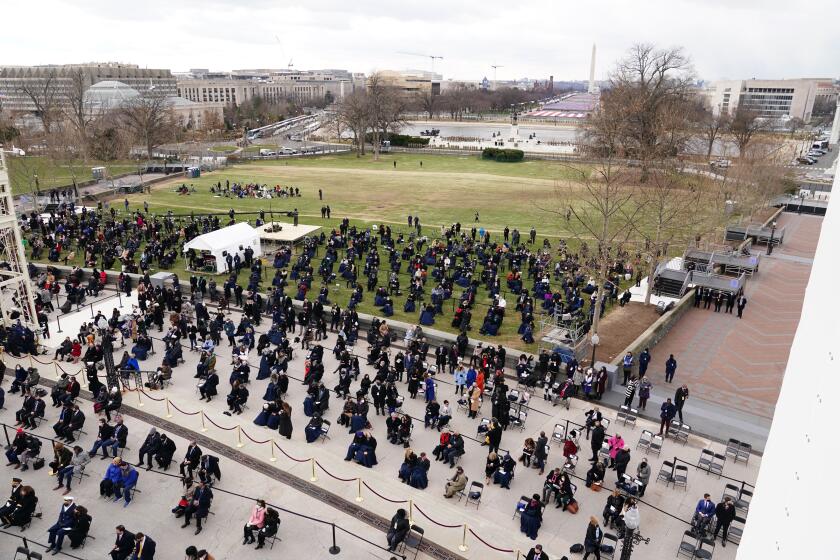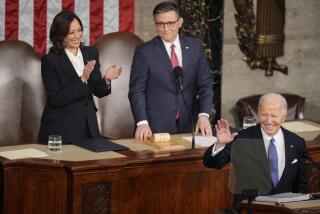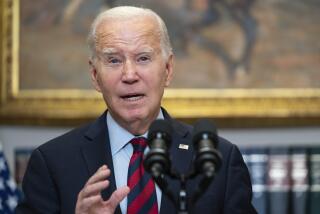Biden immediately turns to boosting federal COVID-19 response
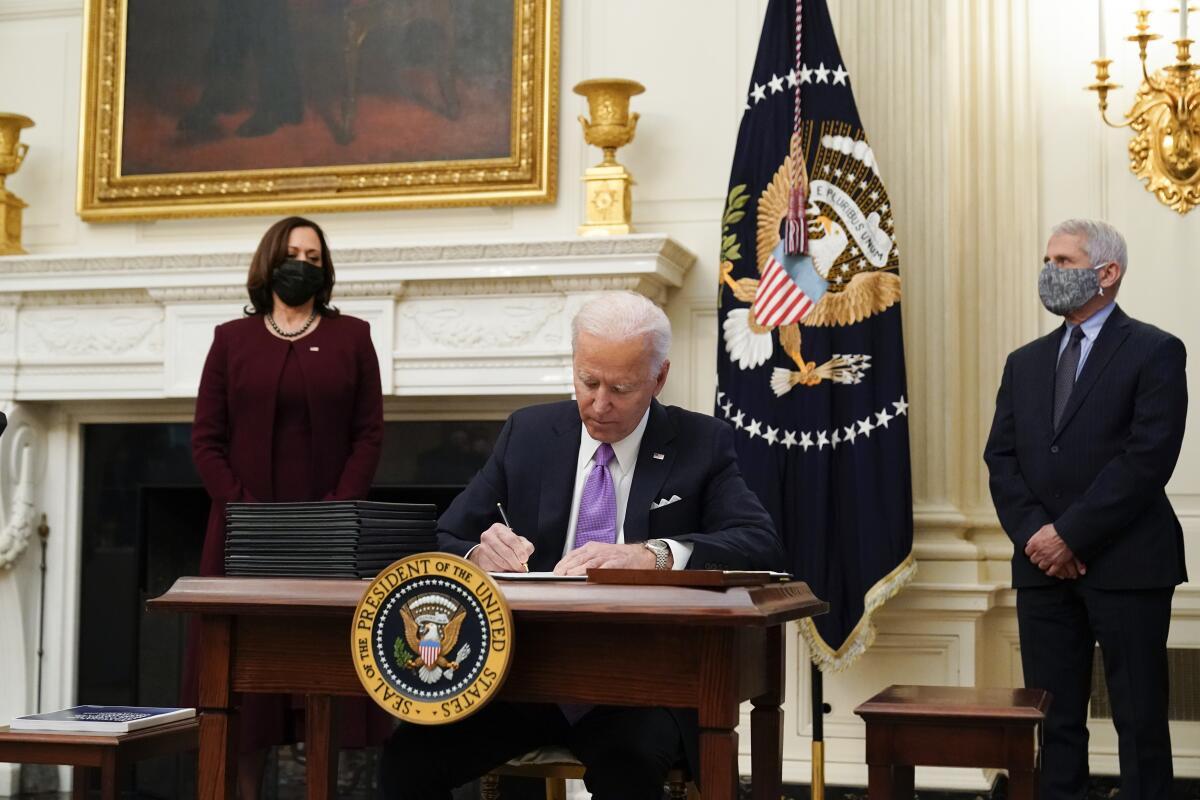
- Share via
WASHINGTON — After months of watching from the sidelines as the coronavirus crisis worsened, President Biden moved swiftly on his first full day in office Thursday to try to assert control over the nation’s pandemic response.
He signed 10 executive orders, including directives to boost the production of vaccines, ensure they reach hard-hit communities and set up more locations where Americans can receive shots — all part of what he called “one of the greatest operational challenges our nation has ever undertaken.”
Biden also charged his administration with developing guidelines for reopening schools and improving data collection to track the battle against COVID-19.
Some of his initiatives are already in place in various forms. For example, he ordered federal agencies to require masks on airplanes and other public transportation, policies that are already enforced by airlines and transit agencies.
President Biden’s inauguration marked a return to a more traditional, unifying politics. But it was a surreal experience amid a pandemic and waves of political violence, which the ceremonies were forced to reflect.
But with each signature the new president applied to the orders, as cameras recorded, he sent a message to beleaguered Americans and overworked local health officials that he and the federal government are taking charge rather than relying on state and local governments and private industries.
“For a nation waiting for action, let me be clearest on this point: Help is on the way,” Biden said in the State Dining Room of the White House before sitting down to sign the orders.
The shift to a centralized government response to the 10-month-old pandemic is a sharp one after former President Trump abdicated responsibility and forced individual states to set their own courses. Trump’s approach frustrated public health experts and state leaders, who warned that the virus was blind to lines on a map and insisted that a national crisis needed a national strategy.
The country recorded a one-day record of 4,409 deaths on Wednesday, the day Biden was inaugurated, and it’s been averaging about 3,000 deaths a day for the last week. December was the deadliest month for the pandemic, and January is proving grim as well.
However, some signs of improvement are evident: The number of daily cases and hospitalizations fell in recent days.
Biden warned as he has before that “things are going to continue to get worse before they get better,” trying to prepare the nation for bad news and perhaps blunt any blame he might otherwise get.
One lesson he drew from his experience in the Obama administration, which took office amid the worst economic crisis since the Depression, is that by failing to sufficiently warn Americans that the recovery could be slow, Democrats in Congress suffered politically when it proved to be so.
Projections show that the COVID-19 death toll, currently at about 410,000, could reach 500,000 next month.
“We didn’t get into this mess overnight, and it’s going to take months for us to turn this around,” Biden said.
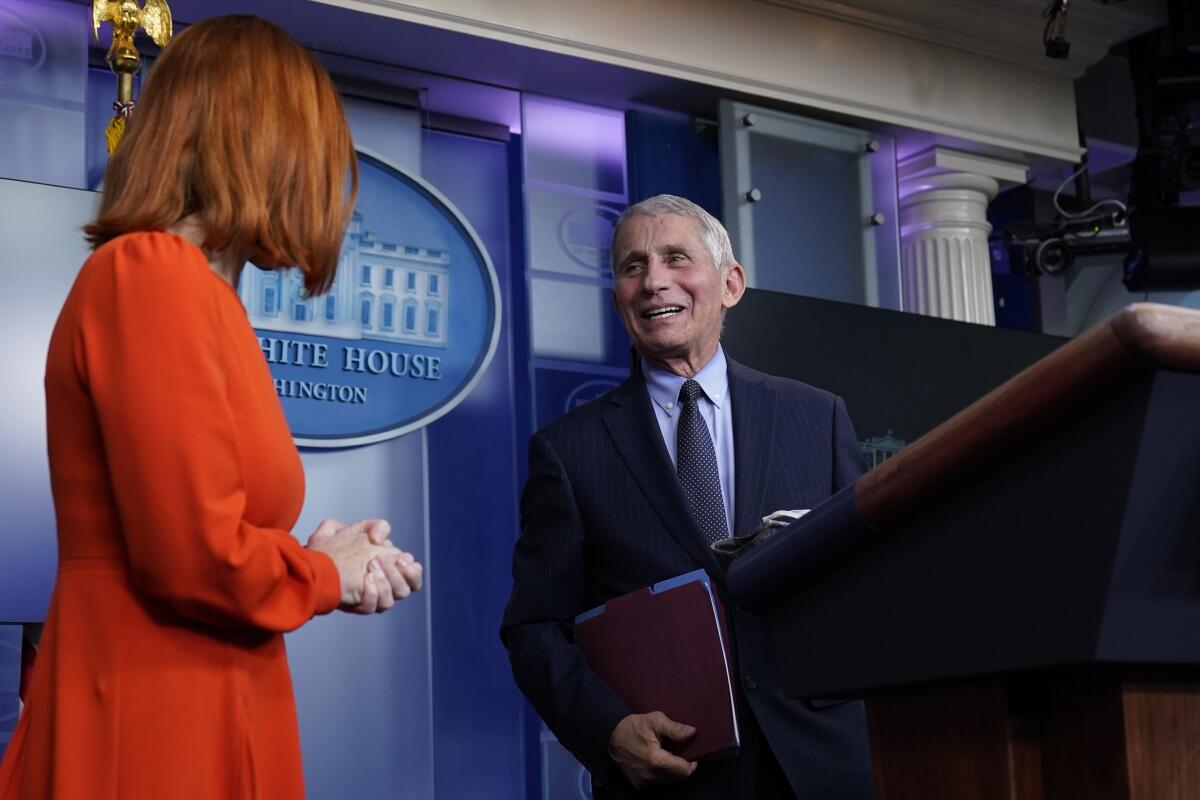
He is also reversing his predecessor’s decision to withdraw from the World Health Organization. Dr. Anthony Fauci, the federal government’s top expert on infectious diseases, told the organization Thursday that the new administration plans to return to an active role in international efforts to distribute vaccines and combat the pandemic globally.
“The United States also intends to fulfill its financial obligations to the organization,” Fauci said. “The United States sees technical collaboration at all levels as a fundamental part of our relationship with WHO, one that we value deeply and will look to strengthen going forward.”
Biden also has promised dramatic changes from how Trump communicated with the public about the pandemic — a difference reflected in the contrast between his own cautionary message and Trump’s consistently positive message despite a rising toll.
Federal agencies, once viewed as the worldwide gold standard for public health guidance, complained of political interference as the pandemic unfolded. Trump sidelined scientists and doctors, holding briefings himself and spreading misinformation about COVID-19. As his administration started recommending masks, Trump declined to wear one, apparently sensitive to the optics.
“I don’t know, somehow sitting in the Oval Office behind that beautiful Resolute Desk — the great Resolute Desk — I think wearing a face mask as I greet presidents, prime ministers, dictators, kings, queens, I don’t know,” he rambled at one point.
When reporters first spotted Biden behind the desk Wednesday, hours after he was sworn in to office, he was wearing a mask. The White House is also welcoming top public health officials back to the briefing room.
“We will be honest, transparent and straightforward with the American people to restore that trust,” said Jeff Zients, who’s leading Biden’s COVID-19 task force. He added, “This is a fundamentally different approach than the Trump administration.”
Fauci attested to the change as he played a central role in Thursday’s White House news briefing.
Appearing more relaxed than in the months he clashed with Trump, Fauci acknowledged that back then, “you didn’t feel like you could actually say something and there wouldn’t be repercussions for it.” Now, he said, “it is somewhat of a liberating feeling.”
Fauci provided updates on how scientists are tracking mutations of the virus, and said he hopes to see 70% to 85% of Americans vaccinated by summer’s end.
If that happens, he said, “I believe that by the time we get to the fall, we will be approaching a degree of normality. It’s not going to be perfectly normal, but one that I think will take a lot of pressure off the American public.”
More work is left to do on Capitol Hill. Biden has proposed a $1.9-trillion package of measures, including to more quickly produce and distribute vaccines, expand unemployment benefits and financially aid state and local governments. The proposal also includes $1,400 in direct payments to individuals, on top of the $600 approved by Trump weeks ago.
House Speaker Nancy Pelosi (D-San Francisco) said her committees would be working on the legislative details so the House would be “completely ready” to push forward at the beginning of February.
“It’s what the people need, what the country needs to crush the virus — put money in the pockets of the American people and honor our heroes,” she said.
More to Read
Get the L.A. Times Politics newsletter
Deeply reported insights into legislation, politics and policy from Sacramento, Washington and beyond. In your inbox twice per week.
You may occasionally receive promotional content from the Los Angeles Times.
